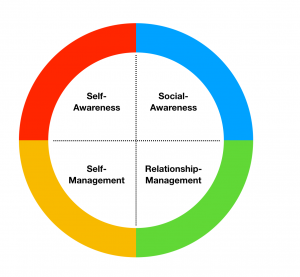Understanding Emotional Competencies in Engineering
Published on September 27, 2018
 Figure 1: Goleman’s Emotional Competencies |
Most would agree that emotional intelligence (EI) is essential to effectively managing and participating in teams, which is a key aspect of engineering work. Yet it’s not often taught in an engineering curriculum or discussed in the workplace. In her IEEE ProComm 2015 conference paper [1] and video interview, Dr. Alex Ilyasova explained the concept of EI, using Daniel Goleman’s model. |
To Goleman, emotional competencies can be broken down into two categories: the personal and the social [2], both of which manifest themselves in how we communicate. In the personal category, EI requires self-awareness and self-management; in the social, social awareness and relationship management (Figure 1) . Working with Goleman’s model, David Caruso and Peter Salovey helpfully break these down further into seven competencies [3]:
- Emotional self-awareness: the ability to identify one’s own feelings and understand their potential impact on thoughts, decisions, and behaviour e.g. I am aware that I am struggling with anxiety and that it may influence my ability to concentrate or make rational decisions in my job today
- Emotional expression: the ability to cultivate greater understanding of yourself amongst your colleagues, contributing to trust and a sense of authenticity e.g. I shared my emotions about my anxiety appropriately and honestly with my colleagues
- Emotional awareness of others: the ability to identify and understand how others may be feeling, and an awareness of the appropriate way of engaging, responding, motivating, and more generally connecting with them e.g. I understood that Tim was angry about a recent decision, and approached him to have a conversation about ways to manage the negative consequences of the decision for him
- Emotional reasoning: the ability to incorporate emotional awareness (self and other) in the process of decision making, as a means of achieving greater buy-in from others on the decisions made e.g. I incorporated my need to make changes, and Tim’s anxiety about them into policy by instituting a twice monthly check-in addressing any problems that could arise, and stressing that these changes were on a trial basis
- Emotional self-management: the ability to turn self-awareness into strategies for managing job satisfaction and performance e.g. I acknowledge my unhappiness with recent management decisions which present significant challenges to my work, but have chosen the participate in a dialogue with the company about them
- Emotional management of others: the ability to interact with others in such a way as to acknowledge and take into account their feelings, in contributing to a positive workplace environment e.g. I asked for feedback – anonymous if necessary – on the new management plan and held a town hall to discuss them
- Emotional self-control: the ability to deal effectively with highly emotional situations, such as conflict, as well as to think and act rationally in stressful situations e.g. I took a five minute time out to cool down and gather my emotions before continuing a contentious discussion of my annual performance
Based on those competencies, we can see that emotional intelligence is a combination of self / social awareness and communication skills that take that awareness into account. The ability to perceive others’ emotional needs and acting and speaking in a manner which acknowledges them can be difficult, but some of the below strategies might help you to develop some of these competencies.
- Reflect and self-evaluate honestly; keep a personal log of your responses to situations at work or home, and observe your interactions with others to understand your own emotional needs; do an emotional skills inventory (such as the SSI) as a starting point, and self-assess its accuracy.
- Reflect on a time that an emotion you were feeling wasn’t acknowledged, and imagine how you might have communicated it more effectively. Did you keep silent, or did you express in a way that was inappropriate or counter-productive? How might you respond differently in the future?
- Observe your interactions with others, and identify cues to specific emotional states in your colleagues; identify a strategy for engaging – whether that is to ignore, address directly, or to simply express concern or care.
- Examine how you (and others) react to stressful situations. Be aware of those tendencies – whether your own or others – when reacting to decisions and develop an appropriate strategy to mitigate them (e.g. take a moment – or five minutes – if necessary and possible)
- Finally, assess your own communication skills and tendencies, taking a moment to consider your audience – and their emotions – before providing any response. Do your communication preferences match your audiences’? Should we change our strategy in light of our audience?
To see how these emotional competencies can influence the performance of engineering teams in concrete ways, see Patricia Sheridan’s series on team work (Parts I, II and III).
[1] A. Ilyasova. “Emotional Competencies: Connecting to the Emotive Side of Engineering and Communication,” 2015 IEEE International Professional Communication Conference (IPCC), Limerick, 2015, pp. 1-5.
[2] D. Goleman. “An EI-based theory of performance,” in The Emotionally Intelligent Workplace, C. Cherniss and D. Goleman, Ed., San Francisco, CA: Jossey-Bass, 2001, pp. 2744.
[3] D. Caruso and P. Salovey. The Emotionally Intelligent Manager. New York: Wiley, 2004.

